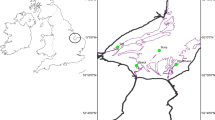Abstract
Numbers of ornamental transgenic fish are increasing, and some of them are illegally imported into Europe. The fish are modified to display different fluorescent colors under UV light. In this article, we propose real-time PCR methods to detect fish presenting green, yellow and red fluorescent coloring. The methods were tested with success and were able to detect illegally imported fish in two European countries. The article also discusses some practical information that can be useful for routine analysis. In addition, a real-time PCR test able to highlight the presence of fish DNA in general is proposed to check the amplifiability of the DNA extracted from common bony fish species of the teleost subclass. Finally, as the testing by PCR can take several days and rapid decisions must be taken with living organisms, we explored the potential of fluorescence microscopy as a screening test to determine whether animals are suspect or can be released.


Similar content being viewed by others
References
AFNOR XP V03-020-2 (2008) Produits alimentaires. Détection et quantification des organismes végétaux génétiquement modifiés et produits dérivés. Partie 2: méthodes basées sur la réaction de polymérisation en chaîne. Norme expérimentale
Alam MW, Wahid KA, Goel RK, Lukong KE (2019) Development of a low-cost and portable smart fluorometer for detecting breast cancer cells. Biomed Opt Express 10:399–410
Auctorum (2007) Annual Report on GM inspection and enforcement activities, 1 April 2006–31 March 2007. The Food and Environment Research Agency UK, GM Inspectorate
Amanuma K, Nakajima N, Hashimoto AH, Aoki Y (2008) Genetically modified, red fluorescent Zebrafish: detection, crossing, inheritance of red fluorescence, and tolerance to low temperatures. J Environ Biotechnol 8:105–110
Broeders S, Huber I, Grohmann L, Berben G, Taverniers I, Mazzara M, Roosens N, Morisset D (2014) Guidelines for validation of qualitative real-time PCR methods. Trends Food Sci Technol 37:115–126
Chen TT, Lin CM, Chen MJ, Lo JH, Chiou PP, Gong HY, Wu JL, Chen MHC, Yarish C (2015) Transgenic technology in marine organisms. Handbook of Marine Biotechnology. Springer, Berlin, pp 387–412
Dai B, Jiao Z, Zheng L, Bachman H, Fu Y, Wan X, Zhang Y, Huang Y, Han X, Zhao C, Huang TJ, Zhuang S, Zhang D (2019) Colour compound lenses for a portable fluorescence microscope. Light-Sci Appl 8:1–13
Debode F, Marien A, Janssen E, Bragard C, Berben G (2017) Influence of the amplicon length on real-time PCR results. Biotechnol Agron Soc 21:3–11
Debode F, Janssen E, Marien A, Devlin RH, Lieske K, Mankertz J, Berben G (2018) Detection of transgenic Atlantic and Coho Salmon by real-time PCR. Food Anal Method 11:2396–2406
Emanuelsen L, Bleken Rud R, Berdal KG, Holst-Jensen A (2009) Molekylærbiologisk deteksjon av genmodifisert sebrafisk (GloFish). Veterinærinstituttets rapportserie—rapport 18–2009. 26 sider. https://www.vetinst.no/rapporter-og-publikasjoner/rapporter/2009/molekylrbiologisk-deteksjon-av-genmodifisert-sebrafisk-glofish. Accessed 9 Dec 2019
Gong Z, Wan H, Tay TL, Wang H, Chen M, Yan T (2003) Development of transgenic fish for ornamental and bioreactor by strong expression of fluorescent proteins in the skeletal muscle. Biochem Biophys Res Commun 308:58–63
Holst-Jensen A (2012) Laboratory report on the detection of RFP-gene in Pink danios. Norwegian Veterinary Institute, 30-11-12, contract 12080052. Available at https://bch.cbd.int/database/record.shtml?documentid=104553. Accessed 28 April 2020
ISO 21571 (2005) Foodstuffs Methods of analysis for the detection of genetically modified organisms and derived products Nucleic acid extraction. International Organization for Standardization, Geneva
Li J, Cai F, Dong Y, Zhu Z, Sun X, Zhang H, He S (2017) A portable confocal hyperspectral microscope without any scan or tube lens and its application in fluorescence and Raman spectral imaging. Opt Commun 392:1–6
Ofelio C, Cariani A, Trentini M, Guarniero I (2012) Novel PCR-based assay for rapid identification of Red Fluorescent Proteins in GloFish and GloFish x wildtype zebrafish (Danio rerio) hybrids. Ital J Zool 79:541–546
Rehbein H, Bogerd J (2007) Identification of Genetically Modified Zebrafish (Danio rerio) by protein- and DNA-analysis. J Verbrauch Lebensm 2:122–125
Strehler BL (1977) Time, cells, and aging. Academic Press, New York, p 270
Udenfriend S (1962) Fluorescence assay in biology and medicine, vol I. Academic Press, New York, p 505
Van den Brandhof EJ, Banus S (2009) Genetisch gemodificeerde siervissen in Nederland. Een gloeiend probleem? RIVM Report 609021084. https://www.rivm.nl/bibliotheek/rapporten/609021084.pdf Accessed 9 Dec 2019
Van den Akker H, Wassenaar A (2012) Potential introduction of unapproved GM animals and GM products in the Netherlands. RIVM Report 609021118. https://www.rivm.nl/bibliotheek/rapporten/609021118.pdf Accessed 9 Dec 2019
Acknowledgements
This research (Agreement RF 11/6242 UGM-MONITOR) was subsidized by the Federal Public Service for Public Health, Food Chain Safety and the Environment. Our thanks go to Mr. Denis Roulez, Mr. Julien Maljean and Ms. Gaelle Antoine of the Authentication and Traceability Unit of CRA-W for their technical assistance. We are grateful to Olivier Fumière from the EURL-AP for his help with collecting samples for specificity testing. We also thank Kelly Lardinois from the Federal Public Service for Public Health, Food Chain Safety and the Environment for fruitful collaboration on the testing of illegally imported fish. Finally, we express our gratitude to Lotte Hougs from the Danish Veterinary and Food Administration for her feedback concerning the positive samples detected with the methods proposed in this paper.
Author information
Authors and Affiliations
Corresponding author
Additional information
Publisher's Note
Springer Nature remains neutral with regard to jurisdictional claims in published maps and institutional affiliations.
Rights and permissions
About this article
Cite this article
Debode, F., Marien, A., Ledoux, Q. et al. Detection of ornamental transgenic fish by real-time PCR and fluorescence microscopy. Transgenic Res 29, 283–294 (2020). https://doi.org/10.1007/s11248-020-00197-9
Received:
Accepted:
Published:
Issue Date:
DOI: https://doi.org/10.1007/s11248-020-00197-9




